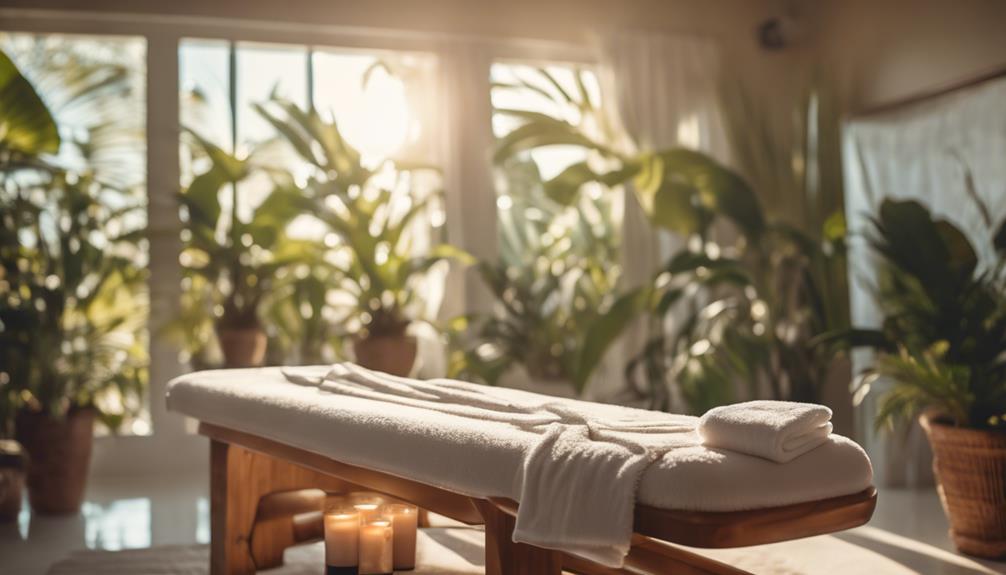To achieve your perfect glow, it is important to identify your skin type first. This will help you select the most suitable tanning sessions for optimal results. Prior to tanning, make sure to exfoliate and moisturize your skin. Gradually build your tan by starting with short sessions and increasing the duration as your skin adapts. Don’t forget to stay hydrated and maintain your tan with regular moisturizer and tan extenders. Always prioritize safety by wearing protective eyewear and monitoring your skin’s reaction. By mastering these techniques, you will achieve a smooth, radiant tan that lasts. There is more to discover to enhance your tanning experience, so keep exploring!
Key Takeaways
- Understand your skin type using the Fitzpatrick Scale to tailor tanning sessions for optimal results.
- Prepare your skin by exfoliating and moisturizing before each tanning session to enhance effectiveness.
- Build your tan gradually, starting with shorter sessions and increasing exposure time as your skin adapts.
- Maintain your tan by regularly hydrating, using tan extenders, and gently exfoliating to prevent peeling.
Understanding Your Skin Type
Understanding your skin type is essential for tailoring your tanning sessions and maximizing results while minimizing risks.
Use the Fitzpatrick Scale to determine your skin type and evaluate how susceptible you're to sunburn. If you have lighter skin, start with brief sessions to gradually build a base tan. Darker skin types can handle longer exposures, but caution is still important.
Knowing your skin type helps you avoid complications and enjoy a safe tanning experience. Always remember that proper preparation enhances your tanning results.
Preparing for Your Tanning Session
Now that you've assessed your skin type, it's time to focus on preparing for your tanning session to guarantee the best results.
Start by exfoliating your skin 24 hours before tanning to remove dead skin and assure an even application. Hydrate your skin thoroughly with a good moisturizer to enhance tanning effectiveness.
On the day of your session, arrive at the salon makeup-free, as cosmetics can block UV rays and impact your tan. If you're using a tanning bed, wear protective eyewear to shield your eyes from harmful rays.
Building a Gradual Tan

Building a gradual tan involves starting with shorter sessions and slowly increasing exposure time to achieve a deeper, more natural-looking color.
For fair skin, aim for 1-2 sessions weekly, while medium skin types can go for 2-3 times. If you have olive skin, consider 3-4 sessions, and darker complexions can benefit from 4-5 times a week.
Always listen to your skin; if it feels sensitive, reduce the frequency or duration of your sessions. Consistency is key, so maintain your routine for the best results.
Keep track of your progress and adjust your sessions based on how your skin responds. This thoughtful approach helps you avoid overexposure while building that beautiful, bronzed glow you desire.
Maintaining Your Tan Effectively
To keep your tan looking vibrant and fresh, focus on regular hydration and moisturization immediately after tanning sessions. This habit not only prevents peeling but also extends the life of your tan. Here's a simple guide to help you maintain your glow:
| Step | Action | Frequency |
|---|---|---|
| Moisturize | Apply tan extender | After every session |
| Hydrate | Drink plenty of water | Daily |
| Exfoliate | Gentle scrub | Once a week |
| Adjust Tan Sessions | Evaluate skin condition | Bi-weekly |
Safe Tanning Practices

Practicing safe tanning techniques is essential to protect your skin from potential damage while achieving a beautiful glow.
Always assess your skin type using the Fitzpatrick Scale to determine the appropriate exposure time. Start with shorter sessions, especially if you have lighter skin, and limit tanning to once a day.
Use protective eyewear during sessions to shield your eyes from harmful UV rays. It's vital to hydrate your skin before and after tanning to enhance your results and maintain skin health.
Regularly monitor your skin's condition to adjust your tanning practices accordingly.
Techniques for Even Tanning
Achieving an even tan often requires you to rotate positions during your sessions and make certain that the tanning bed bulbs are functioning properly.
Staying hydrated is vital, as well-moisturized skin tans more evenly. You should also consider varying your session lengths; shorter sessions on specific areas can help avoid over-tanning and make sure a consistent color.
Mixing different tanning beds exposes your skin to varied wavelengths, which can enhance your overall tan and keep the experience fresh. Additionally, using a tan extender post-session can help maintain an even tone.
Troubleshooting Common Issues

Even with careful techniques for even tanning, you might encounter common issues that can affect your results. Here's a quick guide to troubleshoot those problems:
| Issue | Possible Cause | Solution |
|---|---|---|
| Uneven Tan | Incorrect application | Exfoliate and reapply evenly |
| Skin Irritation | Overexposure or sensitivity | Reduce session duration |
| Fading Tan | Lack of hydration | Moisturize regularly |
| Streaks or Spots | Insufficient blending | Use a tanning mitt for application |
How Can I Achieve the Ideal Glow with Tanning Variety at Home?
Want to achieve the perfect glow at home? Discover the best home tanning secrets for glow. From self-tanning lotions to tanning mousse, there are plenty of options to achieve a sun-kissed look without stepping foot outside. Find the right method and products for a flawless tan in the comfort of your own home.
Conclusion
Now that you're equipped with the knowledge to access your ideal glow, remember: “Variety is the spice of life.”
Embrace different tanning techniques tailored to your skin type, and don't forget to prioritize safety and maintenance.
With a little patience and care, you'll achieve a radiant, even tan that boosts your confidence.
So step into the sun with assurance and enjoy the beautiful results of your personalized tanning journey!










